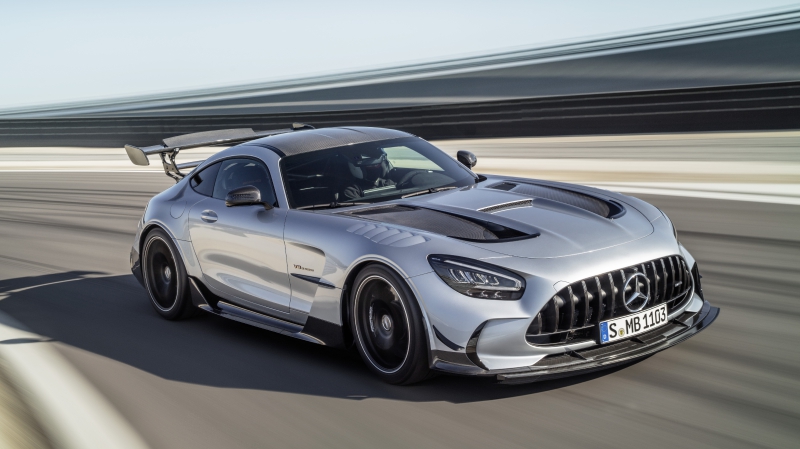You don’t need an economics degree to know that the more you have of something, the less meaningful it becomes. For a name that appeared just five times in 14 years, Mercedes-AMG’s Black Series still stirs the masses. Then again it is easy to get emotional over anything blessed by Mercedes’ horsepower merchants at AMG. In the case of the Mercedes-AMG GT Black Series, the sixth instalment after a five-year absence, it marks the return of AMG’s rock and roll Black Series name.
But first, a brief introduction to what the GT Black Series is. For years, Mercedes-AMG had alluded that the Black Series would make an appearance on its proprietary car, the GT. However, its gestation was not quite straight forward. The GT range was a success, with the range-topping GT R even mounting a challenge to the indomitable 911.

Amid its success story, a prevalent question arose. Should AMG even continue with a hardcore Black Series? Back in 2017, AMG’s head honcho Tobias Moers wasn’t certain if the Black Series would even materialise. Fast forward to 2020 and the GT Black Series is here, and what a beast it is.
The “Black” is back!

As expected of a car wearing the Black Series name, the GT Black Series ups the performance ante. Its 4-litre twin-turbo V8 is a derivative of AMG’s M177/M178 V8, only this time producing 537kW/800Nm. Those figures are a massive 107kW/100Nm over the previous range-topper, the GT R. This power gain wasn’t achieved from slyly upped the boost or dropping in bits and bobs made from exotic metals.

The headlining difference here is that the GT Black Series’ engine sports a flat-plane crank instead of a cross-plane crank. Because of that, it gets a new designation, the M178 LS2. According to AMG, the flat-plane crankshaft allows for a more consistent supply of exhaust gases to spool its cross-bank turbochargers. In layman speak, that means improved power and throttle response.
Inspired by GT3 racing

The new flat-plane crank engine isn’t the only bit of the GT Black Series that gives off motorsport vibes. Its wild aerodynamics package owes its design to the AMG GT’s GT3 racing offshoot. As a result, AMG claims that its massive grille, vented wheel arches, adjustable front splitter, bonnet outlets, rear diffuser, and two-stage rear wing, maximises cooling, lowers air resistance, and increases downforce. Altogether the aerodynamic bits is said to deliver 400kg of downforce at 250km/h. If the GT R’s performance gains were inspired by a racing car, the Black Series is that racing car personified.

In continuing with the Black Series’ “heritage”, there is plenty of carbon-fibre parts strapped to the GT Black Series. Nearly every panel on the GT Black Series has been swapped out for carbon-fibre items. The bonnet, roof, tailgate, “shear panels”, and rear wing are made from the black weave. Underneath that, its prop shaft and adjustable torsion bars too are lightweight carbon-fibre items. Further weight-saving measures on the GT Black Series include ceramic disc brakes and thinner glass panels. Though no kerb weight figure is quoted, the extensive use of lightweight components marks it out as a proper Black Series effort.
History of the AMG Black Series

After half a decade since the C63 Black Series discontinuation, the GT Black Series is a stunning return to form. It looks mad, it sounds quick, and it features extensive modifications, rather than just subtle technical tweaks. Despite a set formula to follow, the Black Series hasn’t been a very consistent performer.
2006 Mercedes-Benz SLK55 AMG Black Series – The first try

In fact, the first Black Series, unveiled in 2006, wasn’t exactly built on solid foundations. Based off the mediocre second-generation Mercedes-Benz SLK55 AMG, the SLK55 AMG Black Series was an uber-expensive track-focused limited-edition special. That looked broadly like the high street variety SLK. Though the finished product didn’t excite, the SLK Black Series came festooned with the now-familiar ingredients. Not only was the power from the naturally aspirated 5.4-litre V8 bumped up by 30kW to 294kW, but the weight was also shaved by a whopping 45kg. This was achieved using a fixed carbon-fibre hardtop, which replaced the folding metal roof, and carbon-fibre front fenders. Unfortunately, its Audi R8 rivalling price and track-focused dynamics meant that the SLK Black Series wasn’t well-received.
2007 Mercedes-Benz CLK63 AMG Black Series – The smash hit

The second effort with the Black Series name, the 2007 Mercedes-Benz CLK63 AMG Black Series, was far better received. Though based on the Formula One safety car, the CLK Black Series wasn’t just a branding exercise. Underneath it packs a tweaked 6.2-litre naturally aspirated V8 producing 373kW/630Nm, beefed-up chassis components, and carbon-fibre flared fenders. Though built to be more touring car than grand tourer, with no rear seats and a stiff ride, the CLK Black Series was regarded by many as one of the best AMG had ever made. Which represents a high-water mark for what was to come next.
2009 Mercedes-Benz SL65 AMG Black Series – The overblown sequel

The 2009 Mercedes-Benz SL65 AMG Black Series had all the ingredients to make it the most extreme AMG ever conceived. Forget naturally aspirated V8s, which were used in the last two Black Series. This Black Series effort was going to utilise AMG’s most powerful engine, its 6-litre twin-turbo V12. With 493kW and 1200Nm to play with and 250kg removed through the same weight-saving techniques used in its SLK counterpart, and a track that was widened by as much as 97mm, the SL Black Series was a luxo-barge gone feral. Unfortunately, pundits found it too feral with an unforgiving nature that was untampered by its 493kW output. That and its astronomical price tag made the SL Black Series a proposition that was too over the top.
C63 Black Series & SLS Black Series – Striking the balance

AMG toned down the madness with the 2011 Mercedes-Benz C63 AMG Black Series and 2013 Mercedes-Benz SLS AMG Black Series. Both cars marked a return to AMG’s highly rated naturally aspirated 6.2-litre V8, with the Blackened C-Class getting a 22kW gain to 380kW and the SLS copping a 44kW increase to 464KW in its Black Series treatment. While both cars featured toughened up components and tweaked suspension, its modifications compared to its base models were relatively tame. No stretched tracks, no complete carbon-fibre reconstruction, no monster power gains as its predecessors. In comparison to the CLK and SL, the Black Series iterations of the C and SLS were modestly tame.
The ultimate AMG badge returns

Nevertheless, despite being not as extreme in its execution as its predecessors did, the C63 Black Series and SLS Black Series were well-received by pundits and punters. Could this be a classic case of scoring the Goldilocks zone? Perhaps.
For the time being it is worth revelling in the GT Black Series’ engineering. Ever since its inception, the Black Series has been a demonstration of what would happen if Mercedes-Benz devoted itself to building an uncompromising performance car.
Though it might have dropped the ball, the sheer audacity behind it more than makes up for its shortfalls. The GT Black Series could have been just a tweaked GT R with bigger turbos and a taller wing. Instead, AMG went the whole Black Series hog with race car aerodynamics and an entirely redone engine. Who cares if it drives like a rocket-powered shopping trolley? The engineering effort behind it alone proves that the Black is back.

